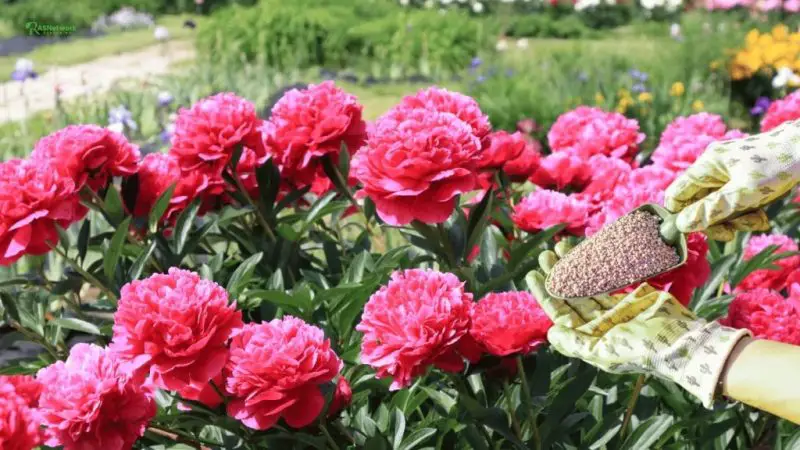Peonies are among the most captivating flowers a gardener can grow, admired for their bold colors, lush petals, and delightful fragrance. Their blooms, which can last for decades when cared for properly, make them a centerpiece in any garden. However, many gardeners underestimate the importance of fertilization in keeping peonies vibrant and full of life. Knowing when to fertilize peonies—and how to do it correctly—can be the key to achieving stronger stems, larger flowers, and long-lasting growth. With the right timing and nutrients, even older peony plants can regain their youthful energy and bloom more brilliantly each season.
Fertilizing peonies is not simply about adding nutrients—it’s about understanding the plant’s natural rhythm. Peonies follow a slow and steady growth cycle, storing energy in their roots long before they bloom. Applying fertilizer at the wrong time can disrupt this rhythm and cause weak stems or poor flowering. By learning the proper fertilization schedule, the right types of nutrients to use, and how soil and weather affect absorption, you can help your peonies thrive for decades. This guide reveals everything you need to know to nourish your plants at the perfect moment for maximum color, health, and bloom intensity.
Understanding Peony Growth and Nutrient Needs

To fertilize peonies effectively, you must first understand how they grow and use nutrients throughout the year. Peonies are perennial plants that follow a distinct growth cycle, storing energy underground during dormancy and using it during active growth. In early spring, they awaken from dormancy as shoots push through the soil. During this stage, peonies rely heavily on nutrients stored in their roots from the previous season. They need phosphorus and potassium to strengthen their roots and prepare for flowering. Fertilizing too early, before the soil warms up, wastes nutrients since the roots cannot absorb them efficiently.
As spring progresses, peonies shift their energy toward bud and flower development. This is when nutrient demand peaks. The plant needs a balanced supply of nitrogen for foliage, phosphorus for roots and blooms, and potassium for overall vigor. However, too much nitrogen can lead to soft stems and fewer flowers. Balanced feeding supports full blooms and sturdy growth. Once flowering ends, the plant enters a recovery phase, storing energy for the next season. Fertilizing during this post-bloom stage helps replenish root reserves, ensuring long-term health and consistent flowering each year.
By late summer, peonies begin preparing for dormancy again. The leaves continue photosynthesis, building energy reserves underground. Fertilizing during this time is unnecessary because the plant focuses on resting, not growing. Understanding these cycles helps you plan when to feed your peonies and when to let them rest. Peonies thrive when nutrients match their natural rhythm, ensuring deep green leaves, resilient stems, and radiant blooms season after season. Knowing how your plant grows is the foundation for fertilizing at the perfect time.
The Best Time to Fertilize Peonies
Timing determines how well peonies absorb nutrients and transform them into strong growth and radiant blooms. The best time to fertilize peonies is in early spring, just as new shoots begin to emerge from the soil. At this stage, the plant is awakening from dormancy and preparing for its most active growth period. Feeding now ensures that the developing stems and buds have the nutrients they need to grow strong. Apply fertilizer after the soil has thawed and warmed slightly, allowing roots to take in nutrients efficiently. This timing supports early development and promotes a full, healthy flowering season ahead.
The second key fertilizing time is immediately after the blooming period ends, usually in late spring or early summer. Once the flowers fade, the plant redirects its energy toward rebuilding its root reserves. A light application of fertilizer during this stage replenishes the nutrients lost during blooming. This helps strengthen the roots and prepare the peony for next year’s growth. Fertilizing at this point ensures that the plant stores enough energy to survive winter and produce even more abundant blooms the following spring. Consistent feeding during this recovery stage promotes long-term vitality and strong root systems.
Avoid fertilizing peonies in late summer or fall. By then, the plant has already begun its dormancy process, and nutrients will not be absorbed effectively. Feeding too late can encourage unnecessary growth that becomes damaged by frost. Instead, let the foliage naturally yellow and die back, allowing the plant to rest. Focusing fertilization in spring and post-bloom ensures peonies get nourishment precisely when they need it most. Proper timing leads to brighter blooms, stronger plants, and years of spectacular color.
Choosing the Right Fertilizer for Peonies
Selecting the right fertilizer is just as important as applying it at the right time. Peonies require a balanced nutrient blend that supports both root and flower development. The ideal fertilizer should contain equal or nearly equal parts of nitrogen, phosphorus, and potassium—often labeled as 10-10-10 or 5-10-5 on the package. Nitrogen encourages healthy foliage, phosphorus strengthens roots, and potassium enhances bloom production and disease resistance. Avoid fertilizers with excessive nitrogen, as this promotes lush green leaves but fewer flowers. A slow-release or organic formula works best because it provides steady nourishment without overwhelming the roots.
Organic options such as compost, bone meal, and aged manure also perform exceptionally well for peonies. These materials release nutrients gradually while improving soil texture and microbial balance. Bone meal, in particular, supplies phosphorus, which peonies need for vibrant, large blooms. Compost enriches the soil naturally, boosting aeration and moisture retention. If your soil is already rich, use fertilizer sparingly to prevent overfeeding. Testing your soil every few years ensures you know exactly what nutrients are lacking, allowing you to adjust fertilizer types accordingly. Healthy soil makes fertilizer more effective and keeps plants thriving for decades.
Granular fertilizers are the easiest to apply, while liquid types provide quick nutrient absorption during active growth. Whichever type you choose, always apply fertilizer around the base of the plant rather than directly on the crown. Water thoroughly afterward to help nutrients soak into the soil. Consistent use of the right fertilizer enhances root strength, promotes steady growth, and ensures long-lasting, colorful blooms each season. With balanced feeding, peonies become stronger, more resilient, and even more breathtaking year after year.
Signs Your Peonies Need Fertilizer
Recognizing when peonies need fertilizer helps you maintain healthy growth and vibrant blooms. The most common sign of nutrient deficiency is poor flowering. If your peonies produce fewer or smaller flowers than usual, they likely lack phosphorus or potassium. These nutrients are essential for strong roots and abundant blooms. Another clear symptom is pale or yellowing leaves, which often indicate nitrogen deficiency. Healthy peony leaves should be dark green, firm, and slightly glossy. Weak, drooping stems and stunted growth also suggest that the soil no longer provides enough nutrients to support the plant’s needs.
Soil conditions can change over time, especially after heavy rainfall or long dry periods. Nutrients may wash away, leaving the soil depleted and unbalanced. Testing your soil once every two to three years can help identify deficiencies early. It also ensures that your fertilizer choice matches what the soil truly needs. When nutrient levels drop, peonies become less resistant to diseases and pests. Regular observation of leaf color, stem thickness, and flowering patterns gives you early warning signs of poor nutrition.
Another indicator is the overall appearance of the plant after blooming. Healthy peonies maintain strong green foliage long after flowers fade. If leaves quickly wilt or turn brown, it means the roots are struggling to replenish energy reserves. In such cases, a balanced fertilizer or organic compost can help restore strength. Addressing these signs promptly ensures your peonies remain vigorous and capable of producing lush, colorful blooms each season. Understanding your plant’s behavior is the first step toward perfect fertilization timing.
How to Fertilize Peonies Step-by-Step
Fertilizing peonies correctly requires timing, precision, and care. Begin the process in early spring when new shoots are about two to three inches tall. Clear away any mulch or debris from around the base to expose the soil. Sprinkle a balanced fertilizer—such as 10-10-10—around the drip line of the plant, not directly over the crown. This ensures that nutrients reach the feeder roots without burning the center. Lightly work the fertilizer into the top inch of soil using your hands or a small garden fork. Water the area thoroughly to help nutrients dissolve and move down into the root zone. Early fertilization sets a strong foundation for healthy growth.
After the first bloom period, a second, lighter feeding helps replenish nutrients lost during flowering. Use half the amount applied in spring and spread it evenly around the base. Avoid fertilizing directly on wet foliage or stems to prevent leaf burn. Water again after feeding to activate the nutrients. If using organic compost or bone meal, mix it gently into the soil to maintain balance. Regular watering after each feeding keeps nutrients available and prevents salt buildup. Always ensure the soil drains well, as peonies dislike sitting in wet, compacted ground. Proper application encourages vibrant color and abundant blooms.
In addition to fertilizing, monitor the condition of the soil throughout the season. If the leaves appear pale or growth slows, it may indicate a lack of nutrients or poor absorption. Adjust your fertilization routine accordingly, using organic matter to support soil health. By following these simple steps consistently, you’ll give your peonies the perfect nourishment they need to produce strong stems, lush foliage, and dazzling flowers every year.
Common Mistakes to Avoid When Fertilizing Peonies
Overfertilizing and Using the Wrong Formula
One of the most common mistakes gardeners make when fertilizing peonies is overfeeding. Many assume that more fertilizer will produce larger flowers, but the opposite is true. Too much nitrogen stimulates excessive leaf growth while reducing the number of blooms. It also weakens stems, making them unable to support heavy flowers. Overfertilized peonies often appear lush but fail to bloom or develop discolored foliage. The best approach is moderation—apply fertilizer only once or twice per season, and always follow package instructions carefully. Using a balanced or slightly phosphorus-rich formula, such as 5-10-5, promotes healthy blooms without overwhelming the plant.
Another problem arises from using the wrong type of fertilizer. Fast-acting chemical fertilizers may give temporary results but can damage roots if applied too often. Instead, slow-release or organic options provide steady nutrients over time. Compost, bone meal, and aged manure feed the soil naturally while improving structure. Avoid fertilizing newly planted peonies during their first year, as young roots are sensitive and can burn easily. Choosing the correct product and applying it in moderation ensures strong growth, long-lasting blooms, and healthy plants that thrive year after year.
Fertilizing at the Wrong Time
Timing mistakes can have a major impact on peony performance. Fertilizing too early, while the ground is still cold, prevents nutrient absorption because the roots remain dormant. The fertilizer can then leach away with rain, wasting both time and nutrients. Similarly, fertilizing too late—after midsummer—encourages new growth that will not mature before frost. This young, soft tissue often freezes and weakens the plant’s structure. The best timing is early spring when shoots first emerge, followed by a lighter feeding after blooming. This schedule matches the plant’s natural nutrient needs and supports steady development.
Weather also plays a role in fertilizing success. Applying fertilizer right before heavy rain can wash nutrients away before the roots absorb them. Choose a calm, dry day with moist soil for best results. Avoid feeding during periods of drought, as nutrients can build up and harm the roots. Always water well after fertilizing to help nutrients penetrate the soil evenly. By aligning fertilization with the plant’s life cycle and climate conditions, you create the perfect environment for continuous, colorful blooms.
Ignoring Soil Health and pH Balance
Ignoring soil health is one of the most overlooked mistakes in peony fertilization. Peonies depend on nutrient-rich, well-drained soil to thrive, and fertilizer alone cannot replace healthy soil structure. If the soil is compacted, acidic, or lacking organic matter, roots struggle to absorb nutrients effectively. Before fertilizing, test the soil’s pH level—it should range between 6.5 and 7.0 for optimal nutrient uptake. If the pH is too low, add garden lime to raise it. For alkaline soils, mix in sulfur or compost to restore balance. Proper pH ensures fertilizers work efficiently and promotes healthy microbial activity.
Many gardeners also skip amending the soil with organic matter, which provides natural nutrients and improves water retention. Adding compost or aged manure in early spring strengthens the soil’s texture and increases fertility. Healthy soil helps fertilizer move evenly through the root zone, preventing buildup or runoff. Fertilizing without first ensuring soil balance can waste nutrients and lead to weak or uneven growth. Peonies grown in well-prepared soil absorb nutrients more efficiently, producing lush foliage, strong stems, and brilliant blooms year after year. Focusing on soil health guarantees long-term success in every fertilization cycle.
Fertilizing Without Watering Properly
Watering and fertilizing must work together to keep peonies healthy. Fertilizer provides essential nutrients, but water delivers them to the roots. Applying fertilizer to dry soil can damage root tips and cause nutrient burn. Always water thoroughly before and after fertilizing to help nutrients dissolve and spread evenly. Moist soil allows fertilizer to move deeper, reaching active roots without harming them. Deep watering once or twice a week supports root development and strengthens the plant’s base. Consistent hydration is essential for proper nutrient absorption and overall plant resilience.
Neglecting watering after fertilization often leads to patchy or uneven growth. Some parts of the plant receive nutrients while others remain deprived. In dry conditions, fertilizer salts can build up, further stressing the plant. Mulching around the base helps retain soil moisture and prevents evaporation. However, avoid piling mulch too close to the crown to prevent rot. Maintaining the right moisture level creates a balanced environment where fertilizer works effectively. When watering and feeding are synchronized, peonies develop healthy roots, vibrant leaves, and long-lasting, radiant flowers that brighten the garden each year.
Caring for Peonies After Fertilizing
Proper care after fertilizing ensures your peonies absorb nutrients efficiently and continue growing strong throughout the season. Once fertilizer is applied, water the soil deeply to help nutrients penetrate the root zone. This prevents surface runoff and keeps minerals where they’re needed most. In the following weeks, monitor the soil’s moisture level closely. The top few inches should stay slightly damp, never soggy. Overwatering after feeding can cause nutrients to leach away, while dry soil blocks absorption. Keeping consistent moisture levels allows peonies to take in nutrients gradually, resulting in strong stems and lush foliage.
Weeding is another important part of post-fertilization care. Weeds compete with peonies for nutrients, especially right after feeding when the soil is rich in minerals. Regularly remove weeds around the base to keep roots free from competition. Applying a thin layer of mulch after fertilizing helps retain moisture, suppress weeds, and regulate soil temperature. Organic mulch like compost, straw, or shredded bark works best because it also adds nutrients as it decomposes. Maintain a small gap between the mulch and the crown to prevent rot and ensure proper airflow. Balanced care keeps the soil active and fertile for months.
Finally, observe your plants for signs of overfeeding or nutrient stress. Excess fertilizer can cause yellowing leaves, weak stems, or poor flowering. If you notice these symptoms, water heavily for several days to flush out excess salts. Avoid feeding again until the plant recovers. At the end of the season, let the foliage die back naturally so nutrients can return to the roots. Caring for peonies properly after fertilizing protects their health, promotes steady growth, and guarantees brilliant, lasting blooms each year.
Long-Term Fertilizing Routine for Healthy Peonies
Establishing a consistent, long-term fertilizing routine keeps peonies vigorous, resilient, and full of color year after year. Mature peonies don’t require heavy feeding, but they do benefit from steady nourishment timed with their natural growth cycle. The first application should occur in early spring when the shoots begin to appear. A balanced fertilizer, such as 10-10-10 or 5-10-5, gives the plant the boost it needs for strong stem and bud formation. A second, lighter feeding right after flowering helps replenish the nutrients used during bloom production. This combination supports both immediate growth and next season’s flower development.
Over the years, peonies also benefit from organic soil enrichment. Compost, leaf mold, and aged manure build long-term fertility and improve the soil’s structure. Each autumn, add a thin layer of organic matter around the base to feed the soil naturally. These organic nutrients release slowly over time, maintaining healthy root growth through winter. Avoid over-fertilizing older peonies, as excessive feeding can reduce bloom quality and cause leaf burn. Instead, focus on maintaining healthy soil balance through natural amendments and consistent seasonal care. Healthy soil equals healthy peonies that bloom stronger every year.
Regular observation is key to sustaining an effective fertilizing routine. Each season, check for changes in leaf color, stem strength, and flowering patterns. These signs reveal whether your fertilizing schedule needs adjustment. Every three to five years, perform a soil test to measure nutrient levels and pH. This ensures your feeding approach remains precise and beneficial. With consistent, moderate fertilization, peonies develop deeper root systems, resist diseases more easily, and reward you with lush, vivid blooms that symbolize endurance, grace, and timeless beauty in your garden.
Organic vs. Chemical Fertilizers for Peonies
Choosing between organic and chemical fertilizers depends on your gardening goals and soil condition. Organic fertilizers such as compost, bone meal, fish emulsion, or aged manure nourish peonies slowly but naturally. They release nutrients gradually, feeding both the plant and the soil ecosystem. Over time, they improve soil structure, moisture retention, and microbial activity. Organic feeding is ideal for gardeners who prefer long-term soil health and steady plant development. Although results take longer, the benefits last for years, keeping peonies strong and disease-resistant. Organic matter also reduces the risk of overfeeding, which can damage roots.
Chemical fertilizers, on the other hand, deliver faster results because their nutrients are immediately available to the plant. A balanced formula like 10-10-10 provides a quick boost in growth and flower production. However, overuse can lead to nutrient buildup, which harms roots and beneficial soil organisms. Chemical fertilizers should always be applied carefully and watered in thoroughly. They are best suited for mature plants that need quick recovery after blooming or show signs of deficiency. Combining both types can be effective when managed wisely.
The ideal approach often involves using organic fertilizers as the foundation and supplementing with chemical feedings during high-demand periods. This method balances long-term soil health with immediate nutrient needs. For sustainable gardening, organic feeding ensures healthy soil and steady growth, while limited chemical use enhances flowering at key stages. Choosing the right fertilizer type allows your peonies to flourish beautifully without compromising the natural balance of your garden.
Seasonal Fertilizing Tips for Peonies
Understanding how seasonal changes affect peonies helps you fertilize at the right moments for maximum results. In early spring, focus on giving your plants a nutrient boost for new growth. Apply a balanced fertilizer when shoots begin emerging from the soil. This feeding supports root expansion and prepares buds for healthy flowering. The nutrients absorbed during spring provide the foundation for strong stems and rich foliage. Always water after fertilizing to help nutrients reach the root zone efficiently.
After the flowering season, in late spring or early summer, peonies need a lighter feeding. At this stage, the plant redirects energy into root recovery and storage for next year’s growth. A fertilizer higher in phosphorus and potassium helps replenish the roots and maintain healthy leaves. Avoid adding too much nitrogen, as it encourages leaf growth instead of building root reserves. This mid-season feeding keeps your plants vigorous and ensures they bloom well the following year.
During fall and winter, peonies enter dormancy and do not need fertilizer. Instead, focus on soil improvement by adding compost or organic mulch around the base. These materials decompose slowly, enriching the soil naturally through winter. When spring returns, your peonies will awaken in nutrient-rich soil, ready to bloom stronger than before. Following seasonal fertilizing patterns creates a steady rhythm that supports long-term health and consistent flowering year after year.
FAQs About Fertilizing Peonies
When is the best time to fertilize peonies?
The best time to fertilize peonies is in early spring when new shoots emerge. A second, lighter feeding after flowering helps replenish nutrients for next year’s blooms. Avoid fertilizing in late summer or fall, as peonies are entering dormancy and will not absorb nutrients efficiently.
What type of fertilizer is best for peonies?
A balanced, slow-release fertilizer such as 10-10-10 or 5-10-5 works best. Peonies benefit from moderate nitrogen for leaf growth and higher phosphorus for strong roots and vibrant blooms. Organic options like bone meal, compost, or aged manure also provide lasting nourishment without harming the soil.
Can overfertilizing harm peonies?
Yes, overfertilizing can cause excessive leaf growth, weak stems, and fewer flowers. It can also lead to salt buildup in the soil, which damages roots. Always follow fertilizer instructions, use moderate amounts, and water well afterward to help nutrients reach the roots safely.
Should I fertilize newly planted peonies?
No, newly planted peonies should not be fertilized during their first growing season. Their roots are still developing and can burn easily. Instead, mix compost into the planting soil before transplanting. Begin fertilizing lightly the following spring once the plant is established.
How do I know if my peonies need fertilizer?
Look for weak stems, yellowing leaves, or reduced blooms as signs of nutrient deficiency. Healthy peonies have deep green leaves and firm growth. Conduct a soil test every few years to check nutrient levels and pH balance, ensuring your fertilizer matches the plant’s needs.
Conclusion
Fertilizing peonies at the right time transforms a good garden into a breathtaking one. With proper timing, balanced nutrients, and healthy soil, your peonies will reward you with larger blooms, stronger stems, and vibrant color every year. Understanding how these plants grow and what they need helps you work with nature, not against it. Whether you prefer organic or chemical feeding, consistency and moderation are the keys to lasting success. Each spring, your well-nourished peonies will burst into life, filling your garden with fragrance, beauty, and the timeless charm that only these magnificent flowers can bring.






